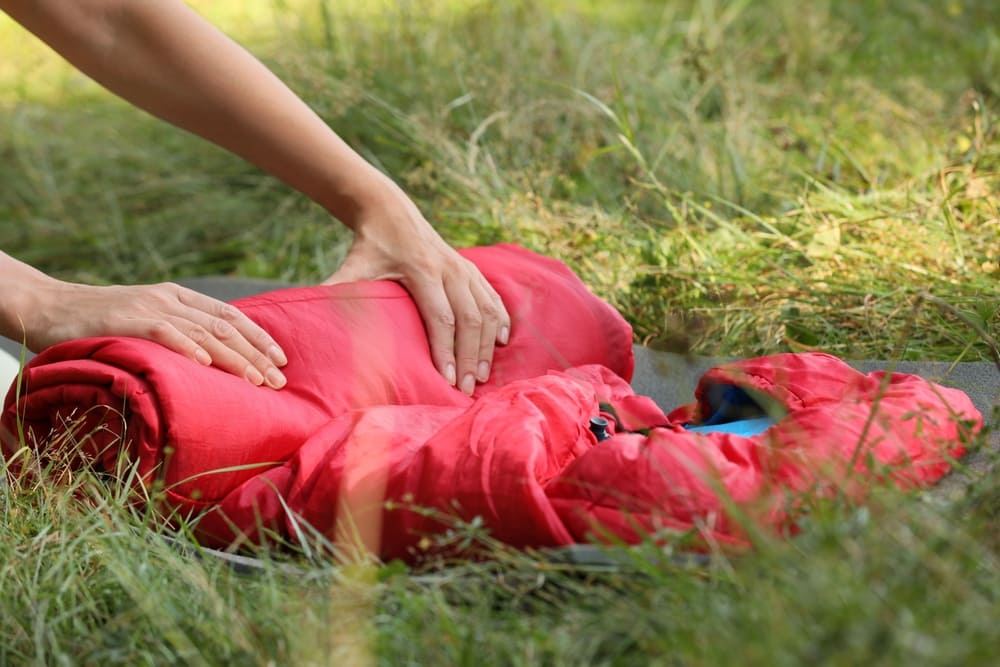Non-toxic sleeping bags are made with natural, organic, or certified toxic-free materials that are free from chemicals like PFAS (per- and polyfluoroalkyl substances), flame retardants, formaldehyde, and other synthetic additives. These chemicals, often found in conventional sleeping gear, can leach into the air or skin, posing potential health risks over time.
In this guide, we’ll explore everything you need to know about non-toxic sleeping bags, from their benefits and key features to top brands and maintenance tips.
Best Non-Toxic Sleeping Bags: Top Brands and Models
1. TETON Sports Sleeping Bags
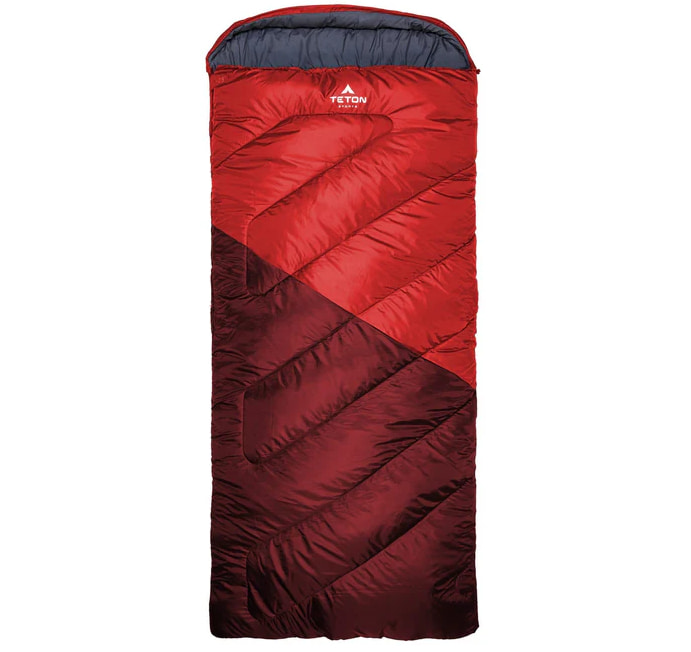
TETON Sports has earned a strong reputation for offering high-quality, durable sleeping bags that prioritize comfort and eco-conscious manufacturing. While not all their models are non-toxic, TETON Sports has introduced several options made with sustainable materials and without harmful chemical treatments.
Key Features of TETON Sports Sleeping Bags:
- Material Safety:
- Some models utilize PFC-free coatings, ensuring no PFAS chemicals for waterproofing.
- Inner linings are made with soft, breathable, and skin-friendly materials like brushed flannel or polyester blends that are free from harsh dyes and irritants.
- Temperature Ratings:
- Wide range of temperature ratings, from lightweight summer models to cold-weather sleeping bags capable of withstanding sub-zero temperatures.
- The TETON Sports LEEF Ultralight Mummy Sleeping Bag is a great example, offering insulation down to 0°F with safe and hypoallergenic materials.
- Versatility:
- Offers designs for various climates and sleeping preferences, including rectangular and mummy-shaped options.
- Lightweight models for backpacking and heavier insulated bags for winter camping.
- Certifications:
- While TETON Sports does not consistently advertise specific eco-certifications, they have committed to eliminating harmful chemicals like PFAS in several product lines.
- Eco-Friendly Practices:
- Emphasis on durability to reduce gear turnover and waste.
- Sustainable packaging initiatives using recyclable materials.
Popular Models:
- TETON Sports LEEF Ultralight Mummy Bag:
- Lightweight and compact, perfect for hikers and backpackers.
- Hypoallergenic materials with an ergonomic design for a snug and warm fit.
- Temperature rating: 0°F to 20°F.
- TETON Sports Celsius Regular Sleeping Bag:
- Flannel lining and adjustable drawstring hood for maximum comfort.
- Free from harsh chemical treatments, making it safer for sensitive skin.
- Temperature rating: 20°F to 40°F.
- TETON Sports Mammoth Double Sleeping Bag:
- Designed for couples or families with plenty of space.
- Uses safe, durable materials and offers excellent insulation for colder weather.
- Temperature rating: 0°F to 20°F.
2. Nemo Sleeping Bags
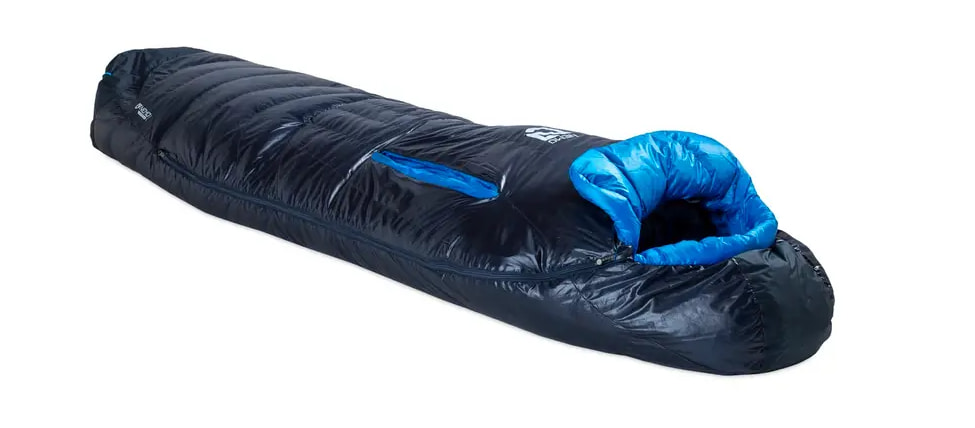
Nemo is a premium brand renowned for its innovative designs and commitment to sustainability, offering an excellent selection of non-toxic sleeping bags. The company prioritizes eco-friendly manufacturing and the use of safe materials, making it a top choice for health-conscious outdoor enthusiasts.
Key Features of Nemo Sleeping Bags:
- Material Safety:
- Many Nemo sleeping bags are crafted using PFC-free water-repellent coatings to eliminate harmful PFAS chemicals.
- Insulation options include recycled synthetic fibers and responsibly sourced RDS-certified down for warmth without toxicity.
- Temperature Ratings:
- Nemo offers a wide temperature range, with bags designed for extreme cold, mild climates, and everything in between.
- The Nemo Disco and Nemo Forte series are particularly popular for their balance of comfort and temperature regulation.
- Certifications:
- Nemo products often carry certifications like Bluesign®-approved fabrics, ensuring sustainable and chemical-safe materials.
- Use of RDS-certified down guarantees ethical and humane sourcing of insulation materials.
- Eco-Friendly Practices:
- Implements sustainable manufacturing processes and minimizes waste during production.
- Utilizes durable materials to extend product life, reducing environmental impact.
Popular Models:
- Nemo Disco 15 Sleeping Bag:
- Spoon-shaped design for enhanced comfort and mobility.
- PFC-free waterproofing and RDS-certified down for safe, non-toxic insulation.
- Temperature rating: 15°F.
- Nemo Forte 20 Sleeping Bag:
- Synthetic insulation made from recycled materials.
- PFC-free DWR (Durable Water Repellent) treatment for eco-friendly water resistance.
- Temperature rating: 20°F.
- Nemo Kyan 35 Sleeping Bag:
- Ultralight option for backpackers, with Bluesign®-approved fabric.
- Synthetic insulation that is hypoallergenic and moisture-resistant.
- Temperature rating: 35°F.
3. Wildkin Sleeping Bags
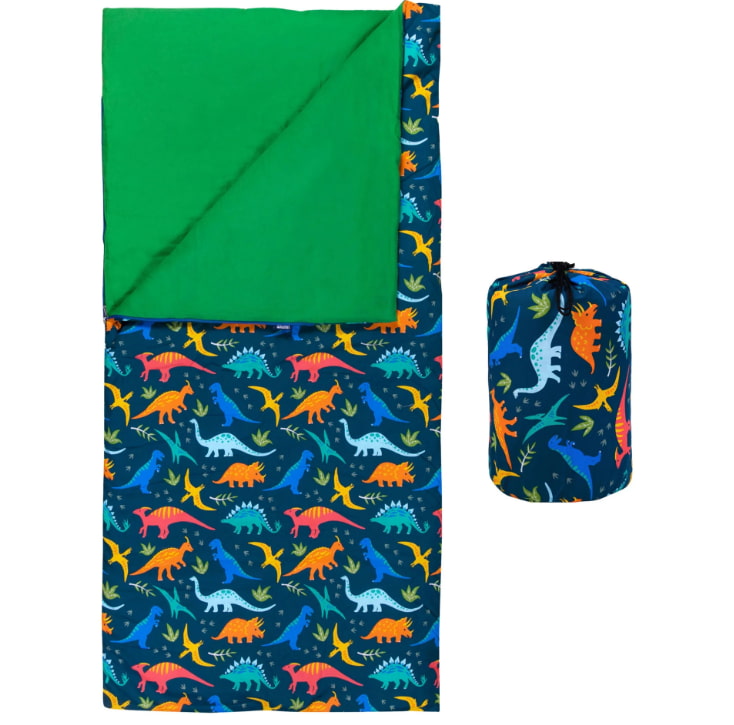
Wildkin specializes in children’s sleeping bags, offering vibrant designs that are safe, fun, and made with non-toxic materials. Their products are a go-to choice for parents looking for sleeping bags that are free of harmful chemicals, while still being comfortable and practical.
Key Features of Wildkin Sleeping Bags:
- Material Safety:
- Made from 100% cotton and soft, skin-friendly fabrics free of flame retardants, formaldehyde, or harsh dyes.
- No use of PVC, BPA, or other toxic additives.
- Certifications:
- OEKO-TEX Standard 100 certification ensures that materials are free from harmful chemicals and safe for children.
- ASTM F963 compliance guarantees safety in every detail, including zippers and trims.
- Temperature Ratings:
- Designed for indoor and mild weather use, Wildkin sleeping bags are cozy but not intended for extreme outdoor conditions.
- Eco-Friendly Practices:
- Focus on durable construction to withstand regular use and reduce the need for frequent replacements.
- Packaging uses recyclable materials to minimize environmental waste.
Popular Models:
- Wildkin Original Sleeping Bag:
- Lightweight and ideal for sleepovers or camping in mild conditions.
- Soft cotton interior and polyester exterior free from harmful chemicals.
- Temperature suitability: Indoor/mild outdoor use.
- Wildkin Nap Mat with Attached Blanket:
- Perfect for toddlers and younger kids, featuring a built-in blanket and pillow.
- OEKO-TEX certified materials ensure safety and comfort.
- Great for daycare, travel, or sleepovers.
- Wildkin Trains, Planes, and Trucks Sleeping Bag:
- Fun, themed designs tailored for kids.
- Free of PVC, BPA, and phthalates.
- Temperature suitability: Indoor/mild outdoor use.
4. Holy Lamb Organics Sleeping Bags
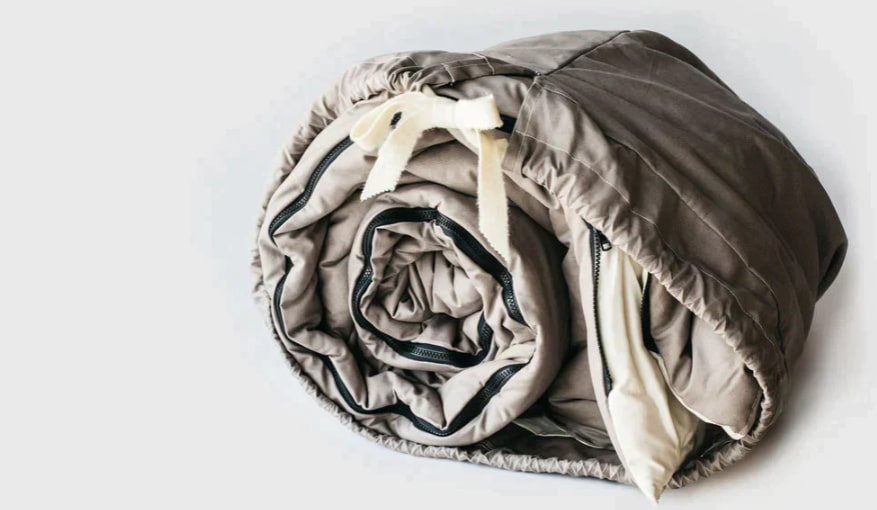
Holy Lamb Organics is a leader in eco-friendly and non-toxic sleeping gear, specializing in handcrafted products made from natural and organic materials. Their sleeping bags are perfect for those seeking a sustainable and chemical-free sleep experience, especially in indoor or mild outdoor settings.
Key Features of Holy Lamb Organics Sleeping Bags:
- Material Safety:
- Made with 100% GOTS-certified organic cotton for the outer shell and lining.
- Insulated with natural wool batting, which is inherently flame-resistant and free from synthetic chemicals.
- Temperature Ratings:
- Designed primarily for moderate climates or indoor use, offering excellent insulation without overheating.
- Wool’s natural temperature-regulating properties ensure year-round comfort.
- Certifications:
- GOTS (Global Organic Textile Standard): Ensures that all textiles are organically produced and processed without toxic chemicals.
- EcoWool™: Wool is sourced responsibly from sustainable farms with strict animal welfare standards.
- Eco-Friendly Practices:
- Handcrafted in the USA using minimal-impact manufacturing techniques.
- Zero waste philosophy in production, with a focus on biodegradable and recyclable materials.
Popular Models:
- Holy Lamb Organics Wool Sleeping Bag:
- Fully organic materials, including an organic cotton shell and EcoWool™ filling.
- Naturally hypoallergenic and flame-resistant.
- Temperature suitability: Indoor/mild outdoor use.
- Holy Lamb Organics Kids’ Sleeping Bag:
- Specifically designed for children, using non-toxic materials to ensure safety and comfort.
- Compact and lightweight, perfect for sleepovers or camping in mild climates.
5. Wiggy’s Sleeping Bags
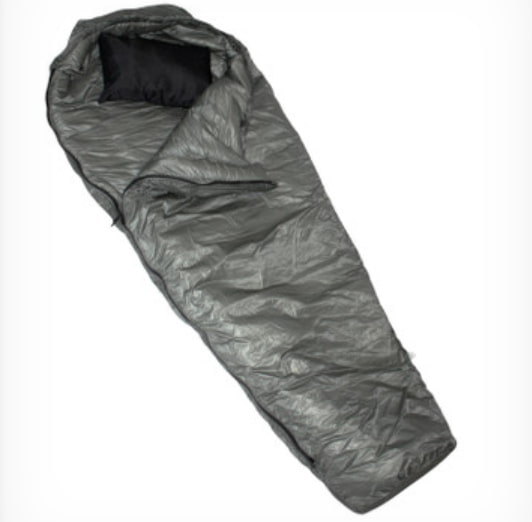
Wiggy’s is a trusted name in the sleeping bag industry, known for producing durable and high-performance sleeping bags designed for extreme conditions. Wiggy’s prioritizes safe and sustainable materials, offering several models that are non-toxic and free from harmful chemical treatments.
Key Features of Wiggy’s Sleeping Bags:
- Material Safety:
- Insulated with Lamilite®, a proprietary synthetic insulation free of harmful chemicals and flame retardants.
- Outer shells are made with durable, chemical-free nylon or polyester.
- Temperature Ratings:
- Wiggy’s offers sleeping bags with ratings as low as -60°F, making them ideal for extreme cold-weather camping or expeditions.
- Their insulation maintains loft and warmth even in wet conditions, providing reliable performance in a range of environments.
- Certifications:
- While Wiggy’s doesn’t carry certifications like GOTS or OEKO-TEX, their focus on avoiding harmful chemical treatments aligns with non-toxic standards.
- Eco-Friendly Practices:
- Emphasis on long-lasting products reduces waste and the need for frequent replacements.
- Wiggy’s recycling program encourages users to return old products for repurposing.
Popular Models:
- Wiggy’s Ultra-Light Sleeping Bag:
- Lightweight and compact, perfect for backpacking or mild-weather camping.
- Features chemical-free insulation and a durable outer shell.
- Temperature rating: 20°F.
- Wiggy’s Antarctic Sleeping Bag:
- Built for extreme cold, with insulation designed to withstand -60°F temperatures.
- PFC-free and hypoallergenic materials ensure safety and comfort.
- Wiggy’s Nautilus Sleeping Bag:
- Versatile and designed for multi-season use, offering exceptional durability.
- Non-toxic Lamilite® insulation ensures safe and effective performance.
- Temperature rating: 0°F.
6. Jacks ‘R’ Better Sleeping Bags
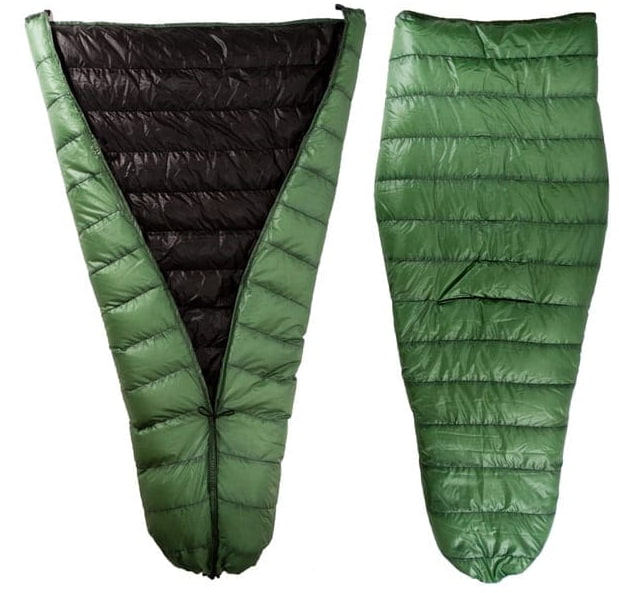
Jacks ‘R’ Better specializes in ultralight and versatile sleeping bags and quilts that prioritize comfort, functionality, and eco-consciousness. Known for their hammock-compatible designs, the brand offers non-toxic options that are free from harmful chemicals, making them a great choice for outdoor enthusiasts.
Key Features of Jacks ‘R’ Better Sleeping Bags:
- Material Safety:
- Uses high-quality, hypoallergenic materials like 900-fill-power down that is RDS-certified, ensuring ethical sourcing and chemical-free insulation.
- Outer shell fabrics are durable and treated with PFC-free water repellents for safety and sustainability.
- Temperature Ratings:
- Designed for a wide range of climates, from mild to cold weather.
- Options like the High Sierra Sniveller Quilt offer excellent warmth in temperatures as low as 0°F.
- Certifications:
- Focus on responsible materials, with down insulation sourced under Responsible Down Standards (RDS).
- PFC-free coatings align with eco-friendly practices.
- Eco-Friendly Practices:
- Lightweight and long-lasting designs reduce waste by eliminating the need for frequent replacements.
- Encourages multi-use functionality, with many products doubling as quilts or top layers.
Popular Models:
- Jacks ‘R’ Better Sierra Sniveller Quilt:
- Ultralight and multi-functional, usable as a top quilt or sleeping bag.
- Made with RDS-certified down and PFC-free outer shell.
- Temperature rating: 0°F.
- Jacks ‘R’ Better Hudson River Quilt:
- Versatile for hammock or ground sleeping.
- Lightweight, with non-toxic down insulation for a cozy, chemical-free sleep.
- Temperature rating: 25°F.
- Jacks ‘R’ Better Greylock 4 Underquilt:
- Specifically designed for hammock campers seeking warmth in extreme conditions.
- Features eco-friendly materials and safe, high-performance insulation.
- Temperature rating: -5°F.
7. Lucky Sheep Sleeping Bags
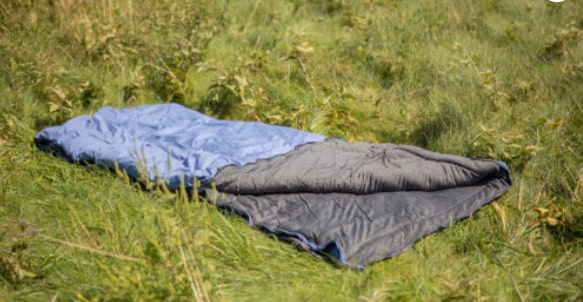
Lucky Sheep is a pioneer in creating 100% natural, chemical-free sleeping bags with an emphasis on sustainability and simplicity. Their products are made exclusively from organic and biodegradable materials, catering to those seeking a truly non-toxic and eco-friendly sleeping solution.
Key Features of Lucky Sheep Sleeping Bags:
- Material Safety:
- Made from organic wool insulation and organic cotton shells, ensuring a fully non-toxic and chemical-free experience.
- Naturally flame-resistant without the need for synthetic flame retardants.
- Temperature Ratings:
- Wool’s natural temperature-regulating properties make these sleeping bags suitable for a wide range of climates, especially mild to cold weather.
- Certifications:
- Uses GOTS-certified organic cotton and EcoWool™ sourced from ethical farms.
- No synthetic coatings, dyes, or treatments.
- Eco-Friendly Practices:
- Focuses on biodegradable and renewable materials to minimize environmental impact.
- Entirely plastic-free production process, with zero waste initiatives.
Popular Models:
- Lucky Sheep Wool Sleeping Bag:
- Lightweight and compact, featuring organic wool insulation and a soft organic cotton shell.
- Perfect for mild weather and indoor use.
- Temperature suitability: 30°F to 50°F.
- Lucky Sheep Winter Sleeping Bag:
- Designed for colder climates, offering extra wool layers for enhanced insulation.
- Organic and biodegradable materials ensure a safe, eco-conscious sleep.
- Temperature suitability: 10°F to 30°F.
8. Feathered Friends Sleeping Bags
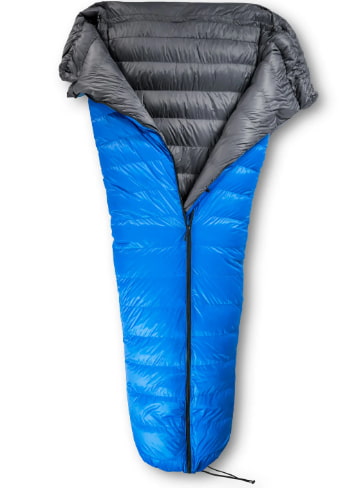
Feathered Friends is a premium brand renowned for its high-performance sleeping bags, crafted with sustainable materials and exceptional attention to detail. Their commitment to safety and eco-friendly practices makes them a standout option for non-toxic sleeping gear.
Key Features of Feathered Friends Sleeping Bags:
- Material Safety:
- Uses RDS-certified down insulation, ensuring ethical sourcing and avoiding harmful chemicals.
- Outer shell fabrics are treated with PFC-free DWR (Durable Water Repellent) for safe and effective water resistance.
- Temperature Ratings:
- Known for sleeping bags with outstanding insulation, Feathered Friends offers models rated for extreme cold (as low as -40°F) as well as mild weather.
- The Hummingbird UL 20 and Snowbunting EX 0 are highly regarded for their warmth-to-weight ratio.
- Certifications:
- RDS-certified down guarantees ethical and humane sourcing.
- PFC-free treatments align with eco-friendly and non-toxic standards.
- Eco-Friendly Practices:
- Durable construction minimizes the need for replacements, reducing waste.
- Responsibly sources materials and incorporates sustainable manufacturing practices.
Popular Models:
- Feathered Friends Hummingbird UL 20 Sleeping Bag:
- Ultralight and compact, perfect for backpackers and climbers.
- PFC-free shell and RDS-certified down for non-toxic, ethical performance.
- Temperature rating: 20°F.
- Feathered Friends Snowbunting EX 0 Sleeping Bag:
- Designed for extreme cold, featuring high-loft down insulation.
- Durable PFC-free fabric ensures water resistance without harmful chemicals.
- Temperature rating: 0°F.
- Feathered Friends Swallow YF 30 Sleeping Bag:
- Lightweight and versatile for three-season use.
- Safe, hypoallergenic down insulation with a durable yet eco-friendly shell.
- Temperature rating: 30°F.
9. Fjällräven Sleeping Bags
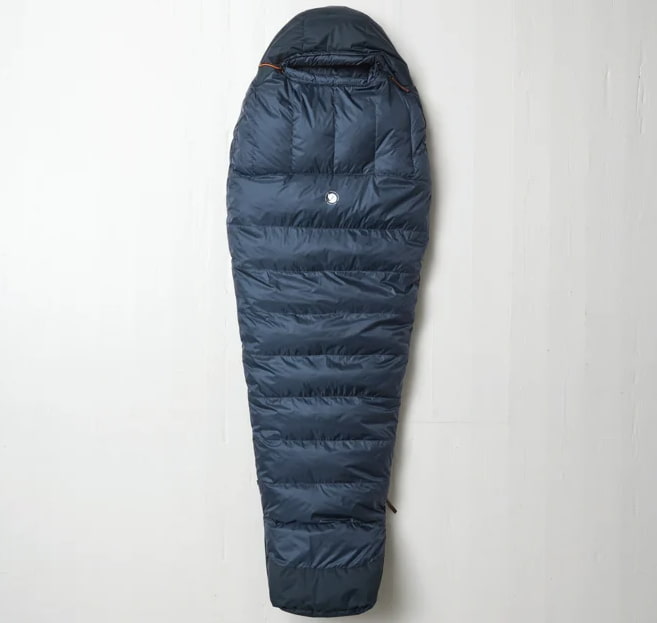
Fjällräven is a Swedish outdoor brand renowned for its durable and eco-conscious gear. Their sleeping bags are no exception, offering high-quality options that prioritize sustainability and non-toxic materials, making them a favorite among environmentally conscious adventurers.
Key Features of Fjällräven Sleeping Bags:
- Material Safety:
- Made with PFC-free DWR treatments for water resistance without harmful chemicals.
- Insulated with options like G-Loft Supreme synthetic fibers or ethically sourced RDS-certified down, ensuring safe and sustainable warmth.
- Temperature Ratings:
- Wide range of temperature ratings, suitable for everything from mild summer nights to sub-zero winter conditions.
- The Singi Three-Season Sleeping Bag is particularly versatile for various climates.
- Certifications:
- RDS-certified down ensures humane and chemical-free insulation.
- Compliance with Bluesign® standards, ensuring eco-friendly and non-toxic manufacturing processes.
- Eco-Friendly Practices:
- Focuses on long-lasting designs to reduce waste.
- Sustainable manufacturing practices, including the use of recycled materials in some product lines.
Popular Models:
- Fjällräven Singi Three-Season Sleeping Bag:
- Combines synthetic and down insulation for optimal performance.
- Features PFC-free water resistance and an ergonomic hood design.
- Temperature rating: 20°F.
- Fjällräven Abisko Three-Season Sleeping Bag:
- Lightweight and compact, ideal for backpacking or moderate climates.
- Made with RDS-certified down and Bluesign®-approved fabric.
- Temperature rating: 25°F.
- Fjällräven Polar -30 Sleeping Bag:
- Built for extreme cold-weather expeditions.
- Insulated with synthetic fibers designed for sub-zero performance without toxic chemicals.
- Temperature rating: -30°F.
Non-Toxic Sleeping Bag Liners: Why They Matter
A non-toxic sleeping bag liner is an essential addition to your camping gear, offering both practical and health benefits. Made with safe, natural materials, these liners enhance your sleeping bag’s performance while keeping harmful chemicals at bay. Here’s why investing in a eco-friendly sleeping bag liner is worth considering.
Benefits of Adding a Liner
Using a sleeping bag liner provides multiple advantages, both for your comfort and the longevity of your sleeping bag:
- Extra Layer of Warmth:
- Liners add an additional layer of insulation, helping retain heat on chilly nights.
- Ideal for extending the usability of your sleeping bag across seasons.
- Hygiene and Cleanliness:
- Acts as a barrier between your body and the sleeping bag, reducing the need for frequent washing of the sleeping bag itself.
- Keeps sweat, dirt, and oils off the sleeping bag’s interior.
- Improved Comfort:
- Liners made from natural, soft materials enhance the sleeping experience, providing a cozy and breathable surface.
- Versatility:
- Can be used on their own in hot climates as a lightweight alternative to a full sleeping bag.
- Easy to pack and carry, making them perfect for travel and backpacking.
- Non-Toxic Benefits:
- Non-toxic liners avoid exposure to harmful chemicals like flame retardants, dyes, or synthetic coatings often found in traditional sleeping bag fabrics.
- Contributes to a safer, healthier sleep environment, especially for individuals with sensitivities.
Materials to Look for in Non-Toxic Liners
The materials used in non-toxic sleeping bag liners are crucial for both comfort and safety. Here are the best options to consider:
- Organic Cotton:
- Soft, breathable, and hypoallergenic.
- Free from synthetic pesticides and toxic dyes, making it ideal for sensitive skin.
- Silk:
- Lightweight, naturally hypoallergenic, and highly breathable.
- Provides a luxurious feel and excellent temperature regulation.
- Bamboo Viscose:
- Sustainable and eco-friendly, bamboo is naturally antibacterial and moisture-wicking.
- Perfect for humid or warmer climates.
- TENCEL™ (Lyocell):
- Derived from sustainably sourced wood pulp, TENCEL™ is biodegradable and gentle on the skin.
- Offers excellent moisture management and a silky texture.
- Merino Wool:
- Naturally temperature-regulating and moisture-wicking, making it suitable for various climates.
- Wool is inherently flame-resistant, eliminating the need for chemical treatments.
Recommended Brands and Models
Here are some top brands and models known for their non-toxic sleeping bag liners:
- Cocoon Travel Sheets and Liners:
- Materials: Organic cotton, silk, and TENCEL™ options available.
- Benefits: Lightweight, breathable, and designed for easy packing.
- Popular Model: Cocoon Organic Cotton Travel Sheet—ideal for camping and travel.
- Sea to Summit Liners:
- Materials: Premium silk and TENCEL™ options.
- Benefits: Durable, compact, and available in various temperature-enhancing designs.
- Popular Model: Sea to Summit Premium Silk Liner—lightweight with superior comfort.
- Therm-a-Rest Sleeping Bag Liners:
- Materials: Soft polyester and eco-friendly blends.
- Benefits: Adds warmth and comfort while being easy to clean and maintain.
- Popular Model: Therm-a-Rest Synergy Sheet—perfect for pairing with sleeping pads and bags.
- REI Co-op Sleeping Bag Liners:
- Materials: TENCEL™ and organic cotton options.
- Benefits: Affordable, durable, and sustainably sourced.
- Popular Model: REI Co-op Cotton Travel Liner—a budget-friendly non-toxic choice.
- Big Agnes Wool Sleeping Bag Liners:
- Materials: Merino wool for natural warmth and comfort.
- Benefits: Flame-resistant, moisture-wicking, and eco-friendly.
- Popular Model: Big Agnes Wool Liner—ideal for colder conditions.
Key Points to Consider
Harmful Chemicals in Traditional Sleeping Bags
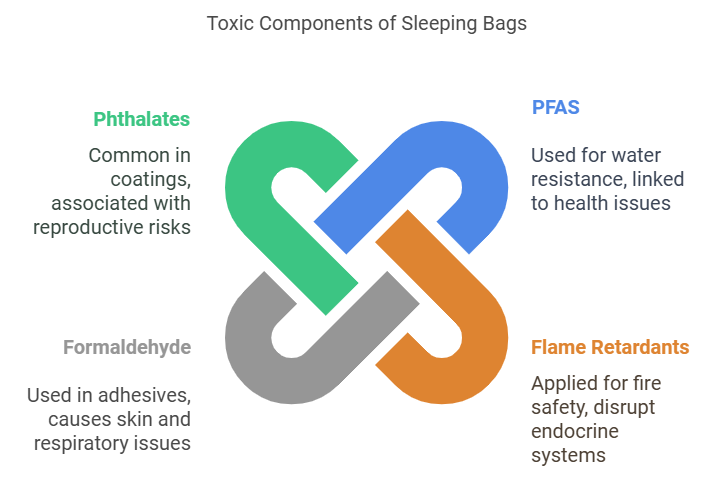
Traditional sleeping bags often use materials and treatments aimed at enhancing durability, waterproofing, or flame resistance. Unfortunately, these treatments introduce toxic chemicals:
- PFAS (Per- and Polyfluoroalkyl Substances):
- Often used for water resistance.
- Linked to various health concerns, including hormone disruption and potential carcinogenic effects.
- Persistent in the environment, earning the nickname “forever chemicals.”
- Flame Retardants:
- Applied to meet fire safety standards.
- Contain substances such as polybrominated diphenyl ethers (PBDEs), which can disrupt endocrine systems and harm development in children.
- Formaldehyde:
- Used in adhesives or coatings.
- Known to cause skin irritation and respiratory problems.
- Phthalates:
- Common in waterproof coatings.
- Associated with reproductive health risks and environmental harm.
Benefits of Choosing Non-Toxic Options
1. Health Benefits
- Reduced risk of allergic reactions, skin irritations, and respiratory problems.
- Elimination of long-term exposure to endocrine disruptors or carcinogenic chemicals.
2. Environmental Impact
- Non-toxic sleeping bags often use biodegradable materials, reducing waste in landfills.
- Avoidance of persistent chemicals like PFAS prevents contamination of soil and water.
3. Sustainability
- Many brands prioritize ethical sourcing, fair trade practices, and reduced carbon footprints.
- Renewable and recyclable materials like organic cotton or TENCEL™ promote resource conservation.
Temperature Ratings and Climate Suitability
Non-toxic sleeping bags should also be functional for your intended use, whether for camping, backpacking, or indoor use. Consider these temperature-related factors:
- Temperature Ratings:
- Sleeping bags are rated for comfort, transition, and extreme temperatures.
- Look for a bag suited to the lowest temperature you expect to encounter during your adventures.
- Climate Adaptability:
- For warm climates: Choose lightweight, breathable options made from materials like organic cotton or bamboo.
- For cold climates: Opt for well-insulated bags using wool or high-performance down alternatives.
- Seasonal Use:
- 3-season sleeping bags: Ideal for spring, summer, and fall, providing moderate insulation.
- Winter sleeping bags: Feature extra insulation for extreme cold.
Eco-Friendly Manufacturing Processes
The sustainability of a non-toxic sleeping bag doesn’t end with its materials—it also extends to how it’s made. Look for brands committed to ethical and environmentally responsible practices.
- Energy-Efficient Production:
- Companies that utilize renewable energy sources and minimize carbon emissions in their manufacturing process.
- Recycled or Biodegradable Packaging:
- Opt for brands that avoid plastic and use recyclable or compostable materials for packaging.
- Fair Trade Practices:
- Brands certified for ethical labor practices and fair wages.
- Circular Economy Initiatives:
- Programs that encourage recycling or returning old sleeping bags for responsible disposal or repurposing.
Alternatives to Sleeping Bags for a Non-Toxic Sleep Setup
If traditional sleeping bags aren’t your preference or you’re looking for versatile, non-toxic sleep solutions, there are excellent alternatives to consider. From blankets to sheets and pillows, you can create a safe, comfortable, and eco-friendly sleeping setup tailored to your needs.
Using Blankets Instead of Sleeping Bags
Benefits and Drawbacks of Blankets
Benefits:
- Versatility: Blankets can be layered for varying levels of warmth or used as standalone options in mild weather.
- Non-Toxic Options: Many blankets are made from organic or natural materials, free from harmful chemicals found in some sleeping bags.
- Comfort: Provide a more open and home-like sleeping experience, especially for those who dislike the confined feeling of sleeping bags.
- Easy Maintenance: Typically easier to wash and dry compared to sleeping bags.
Drawbacks:
- Limited Insulation: May not provide sufficient warmth in extremely cold conditions unless layered.
- Less Portable: Bulkier and heavier than compact sleeping bags, making them less suitable for backpacking.
Best Non-Toxic Camping Blankets
- Rumpl Original Puffy Blanket:
- Materials: Made with 100% recycled polyester and PFC-free water-resistant coating.
- Benefits: Lightweight, packable, and warm enough for cool nights.
- Eco-Credentials: Certified B Corporation and focuses on sustainability.
- Eddie Bauer Reversible Throw Blanket:
- Materials: Organic cotton exterior with hypoallergenic filling.
- Benefits: Soft, comfortable, and suitable for mild weather camping.
- Eco-Credentials: OEKO-TEX Standard 100 certified.
- Coyuchi Organic Cotton Blanket:
- Materials: 100% GOTS-certified organic cotton.
- Benefits: Breathable and ideal for warmer climates.
- Eco-Credentials: Ethical and sustainable production practices.
- Big Agnes Insulated Blanket:
- Materials: Synthetic insulation made from recycled materials.
- Benefits: Compact and warm, suitable for cooler camping conditions.
- Eco-Credentials: PFC-free and eco-conscious production.
Non-Toxic Camping Sheets
Why Sheets Can Be a Good Alternative
- Breathability: Camping sheets made from organic materials offer excellent airflow, preventing overheating during the night.
- Lightweight: Easier to pack and carry, making them a great option for mild-weather camping or layering.
- Non-Toxic Benefits: Sheets made with natural fibers like organic cotton or bamboo are free from harmful chemicals, offering a safer sleep surface.
Top Eco-Friendly Camping Sheet Options
- Sea to Summit Adaptor Coolmax Liner:
- Materials: Made from lightweight and breathable Coolmax fabric.
- Benefits: Moisture-wicking and hypoallergenic, ideal for warm-weather camping.
- Eco-Credentials: PFC-free and sustainable design.
- REI Co-op Organic Cotton Travel Sheet:
- Materials: 100% organic cotton.
- Benefits: Comfortable, easy to clean, and versatile for layering.
- Eco-Credentials: Certified organic and environmentally responsible production.
- Ettitude Bamboo Lyocell Sheets:
- Materials: Made from sustainably sourced bamboo.
- Benefits: Soft, moisture-wicking, and biodegradable.
- Eco-Credentials: OEKO-TEX Standard 100 certified.
- Therm-a-Rest Synergy Sheet:
- Materials: Polyester and eco-friendly blends.
- Benefits: Designed to pair with sleeping pads for a more comfortable camping experience.
- Eco-Credentials: Durable and made with sustainability in mind.
Non-Toxic Camping Pillows
Non-toxic camping pillows are essential for maintaining proper support and ensuring a healthy sleep environment. Many traditional pillows contain synthetic materials and chemical flame retardants, which can off-gas and cause health concerns over time. A toxin-free pillow enhances comfort and peace of mind.
Best Brands and Models for Camping Comfort
- Avocado Organic Mini Pillow:
- Materials: Organic cotton cover and natural latex filling.
- Benefits: Compact, supportive, and eco-friendly.
- Eco-Credentials: GOTS and GOLS certified.
- Therm-a-Rest Compressible Pillow:
- Materials: Made with recycled foam and polyester.
- Benefits: Lightweight and compressible, perfect for backpacking.
- Eco-Credentials: PFC-free and sustainably manufactured.
- Hest Pillow:
- Materials: Memory foam and polyester blend.
- Benefits: Provides excellent neck support while being free from harmful chemicals.
- Eco-Credentials: Uses recycled materials and sustainable practices.
- Savvy Rest Travel Pillow:
- Materials: Organic cotton cover with natural latex filling.
- Benefits: Soft and compact, ideal for camping or travel.
- Eco-Credentials: GOTS and GOLS certified.
How to Choose the Right Non-Toxic Sleeping Bag for Your Needs
Selecting the perfect non-toxic sleeping bag involves balancing health-conscious materials with practical considerations like size, weight, seasonality, and budget. Here’s a comprehensive guide to help you choose a sleeping bag that meets your specific needs.
Key Considerations
- Size and Fit:
- Regular vs. Long: Ensure the sleeping bag is long enough to comfortably accommodate your height.
- Width: Some sleeping bags are designed for extra room (ideal for side sleepers or restless sleepers), while others are snug for better heat retention.
- Kids’ Sizes: For children, opt for models specifically sized for smaller bodies to ensure proper insulation.
- Weight:
- Backpacking: Look for lightweight models that pack down small, typically under 2-3 pounds, for easy portability.
- Car Camping: Weight is less of a concern, so you can choose thicker, more luxurious options.
- Home Use: Heavier and bulkier bags with extra padding may provide added comfort.
- Seasonality:
- Summer Bags: Lightweight and breathable materials like organic cotton or bamboo work well for warm nights.
- Three-Season Bags: Opt for medium insulation and temperature ratings around 20°F to 30°F for spring, summer, and fall.
- Winter Bags: Choose heavily insulated options with down or synthetic fills, and a temperature rating below 0°F for extreme cold.
- Budget:
- Affordable Options: Brands like Suisse Sport and Wildkin offer budget-friendly non-toxic sleeping bags for light use.
- Premium Choices: Brands like Feathered Friends and Holy Lamb Organics provide high-quality, sustainable materials and superior insulation for a higher price point.
- Consider Durability: Investing in a durable sleeping bag reduces long-term costs by minimizing replacements.
Matching Your Sleeping Bag to Your Activity
- Camping:
- Prioritize durability and comfort, as weight is typically less critical for car camping.
- Consider bags with extra padding or wider dimensions for added luxury.
- Example: Big Agnes Anvil Horn 15 (lightweight and non-toxic for versatile camping).
- Hiking and Backpacking:
- Look for lightweight and compact sleeping bags to minimize load.
- Insulation materials like RDS-certified down or high-performance synthetic alternatives provide warmth without bulk.
- Example: Nemo Disco 15 (ultralight and PFC-free for backpacking).
- Home or Indoor Use:
- Non-toxic sleeping bags for home use should emphasize comfort and breathable materials, like organic cotton or bamboo.
- These options can double as cozy alternatives for sleepovers or lounging.
- Example: Wildkin Original Sleeping Bag (perfect for kids’ sleepovers or light indoor use).
Tips for Choosing the Right Non-Toxic Sleeping Bag
- Check Certifications: Look for trusted labels like GOTS, RDS, OEKO-TEX, or Bluesign® to ensure non-toxic and eco-friendly materials.
- Think About Climate: Choose a sleeping bag with appropriate insulation for the temperatures you’ll encounter most frequently.
- Consider Add-Ons: Liners, pads, and non-toxic camping pillows can enhance your setup and provide additional comfort and insulation.
Maintenance and Care for Non-Toxic Sleeping Bags
Proper maintenance of your non-toxic sleeping bag is crucial for preserving its health-friendly and eco-conscious qualities. With the right care, you can extend its lifespan, keep it performing well, and minimize environmental impact.
Cleaning and Storing Your Sleeping Bag Without Compromising Its Non-Toxic Properties
Cleaning Your Non-Toxic Sleeping Bag
Non-toxic sleeping bags are made with materials free from harmful chemicals, so it’s essential to clean them gently to avoid damaging their properties.
- Spot Cleaning for Minor Dirt:
- Use a damp cloth with mild soap (such as a plant-based or fragrance-free detergent).
- Focus on areas like the hood and zipper, which tend to collect oils and dirt.
- Machine Washing:
- Check the Label: Follow the manufacturer’s washing instructions to avoid damage.
- Use Gentle Detergent: Opt for non-toxic, biodegradable detergents free from phosphates, fragrances, or harsh chemicals.
- Set Gentle Cycle: Use cold or lukewarm water and a gentle cycle to preserve the fabric and insulation.
- Avoid Fabric Softeners: These can compromise the bag’s breathability and insulation properties.
- Drying:
- Air-dry the sleeping bag in a shaded, well-ventilated area.
- For down or synthetic fills, tumble dry on low heat with dryer balls to restore loft.
Storing Your Non-Toxic Sleeping Bag
- Avoid Compression:
- Store your sleeping bag in a large, breathable storage sack (often provided by the manufacturer).
- Avoid long-term storage in a compression sack, which can damage insulation.
- Keep It Dry:
- Ensure your sleeping bag is completely dry before storing to prevent mold or mildew growth.
- Use a dry, cool area for storage to protect the materials from heat or humidity.
- Prevent Odors:
- Add a sachet of natural lavender or baking soda to the storage sack to keep the sleeping bag fresh without using chemical deodorizers.
Repair and Longevity Tips to Reduce Waste
Repairing Your Non-Toxic Sleeping Bag
- Fixing Tears and Holes:
- Use fabric patches or repair tape designed for outdoor gear, such as Tenacious Tape.
- For natural materials like cotton or wool, sew small tears using organic thread.
- Replacing Zippers:
- If a zipper breaks, consider taking the sleeping bag to a repair specialist rather than replacing the entire bag.
- Some brands offer repair services to extend the life of their products.
- Re-Fluffing Insulation:
- For down-filled sleeping bags, restore loft by gently fluffing the bag after drying or using a dryer on low heat with dryer balls.
Longevity Tips
- Use a Liner:
- Add a non-toxic sleeping bag liner to protect the interior from sweat, oils, and dirt, reducing the need for frequent washing.
- Protect the Bag During Use:
- Use a ground pad or tarp under your sleeping bag to prevent abrasion or moisture exposure when camping.
- Rotate Usage:
- If you own multiple sleeping bags, rotate them to prevent excessive wear on one bag.
- Recycling and Upcycling:
- If your sleeping bag becomes unusable, consider donating it for upcycling or repurposing the materials into other items like pillows or pet beds.
Frequently Asked Questions About Non-Toxic Sleeping Bags
Are Non-Toxic Sleeping Bags More Expensive?
Non-toxic sleeping bags can sometimes be more expensive than conventional options, but the price varies based on materials, brand, and features.
Why They May Cost More:
- Premium Materials: Non-toxic sleeping bags often use organic, natural, or sustainably sourced materials like GOTS-certified organic cotton or RDS-certified down, which can increase production costs.
- Eco-Friendly Processes: Ethical manufacturing practices and certifications, such as OEKO-TEX or Bluesign®, add to the value and production expense.
- Durability: Many non-toxic sleeping bags are designed to last longer, offering better long-term value despite the higher upfront cost.
Budget-Friendly Options:
- Brands like Wildkin and Suisse Sport offer affordable non-toxic sleeping bags, especially for light use or kids.
- Shopping during sales or choosing simpler designs without high-performance features can help reduce costs.
Can I Find Non-Toxic Sleeping Bags for Kids?
Yes, there are plenty of non-toxic sleeping bags designed specifically for kids. These are tailored to fit smaller bodies and often come in fun designs while prioritizing safety and comfort.
Features to Look For:
- Child-Safe Materials: Look for sleeping bags made with organic cotton or hypoallergenic synthetic fibers.
- Chemical-Free: Ensure the sleeping bag is free of flame retardants, phthalates, and formaldehyde.
- Easy to Clean: Kids’ sleeping bags are often subjected to spills and dirt, so opt for options that can be easily washed with toxic-free detergents.
Top Brands for Kids:
- Wildkin: Offers colorful, fun designs made from safe, toxic materials.
- Holy Lamb Organics Kids’ Sleeping Bag: Features organic cotton and natural wool insulation for ultimate safety and comfort.
- REI Co-op Kindercone: A versatile, chemical-free sleeping bag that adjusts in size as your child grows.
How Do I Know if a Sleeping Bag Is Free from Harmful Chemicals?
Identifying a non-toxic sleeping bag requires attention to certifications, material descriptions, and the brand’s transparency about their manufacturing processes.
Key Indicators of a Non-Toxic Sleeping Bag:
- Certifications:
- GOTS (Global Organic Textile Standard): Verifies that textiles are organic and free of harmful chemicals.
- OEKO-TEX Standard 100: Ensures that every component of the sleeping bag is free from toxic substances.
- Bluesign®: Focuses on eco-friendly and safe production practices.
- RDS (Responsible Down Standard): Certifies ethically sourced and chemical-free down insulation.
- Material Listings:
- Look for terms like “organic cotton,” “natural wool,” “PFC-free,” and “hypoallergenic.”
- Avoid materials with vague descriptions like “treated for durability” or “flame-resistant” without further details.
- Brand Transparency:
- Reputable brands like Nemo, Feathered Friends, and Fjällräven openly share their commitment to non-toxic practices and certifications.
- Check the company’s website or product tags for specific details about materials and treatments.
